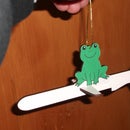Introduction: Electronics Components Storage Cabinet II
An earlier project accommodated a lot of my components, but there were still a lot stored in larger plastic cases which needed a home.
So I built a cabinet to hold those cases. For other reasons, I wanted a slightly taller case, so I made room in the bottom for a bench PSU.
Sizings (in metric I'm afraid):-
Each case was 380mm wide
Each case was 65mm tall
The PSU is 160mm high
The plywood was 18mm thick
The aluminium extrusions I used to hold the cases were 4mm thick.
In sizing, I allowed 3mm elbow room per case on height and width to allow for ease of withdrawal, leaving the finished cabinet with external dimensions of 700x430x340 (HxWxD)
Step 1: Making the Carcass
This project took about a quarter of a sheet of ply. It was CD grade, so making sure that the ugliest bits were hidden took a bit of thought.
The wood was varnished before I started cutting, with the expectation that I would need to touch it up once everything was assembled.
After I'd cut the pieces, I stacked them together to do a quick sanity check that the cases would fit. Better to find out sooner than later if there's a horrible problem. In this case, there wasn't. Nor was there an earthquake while the boards were so precariously balanced.
Once that was checked, I paired the sides in workmate and used a router to cut a rebate to allow the back panel to be fitted. Repeat for the top and base, but don't cut the rebate all the way to the corner.
Then assemble the sides, top and bottom with glue and countersunk screws.
Finally do a last check that the diagonals are equal, then fit the back into the rebated space for it and glue and screw.
Step 2: Rails - and Why Bees Are Your Buddies
Measure the length needed for the aluminium rails on which the cases will sit. I cut them with a 45 degree angle so that they looked less harsh from the front.
After cutting with an angle-grinder, there are a lot of rough edges around. They can be smoothed off with a medium file.
As a learning from the previous cabinet, aluminium is easy to file, but it does clog the tool up quite badly. Rubbing a stick of beeswax on the file before you set to the metal will make it a lot easier to clean up afterwards. Use a brass wire-brush to avoid damaging your file.
Once the aluminium could be handled without ripping my hands, I used a drill press to put a couple of holes in each piece for the screws which would hold it to the cabinet sides. I discovered here that putting a waste bin underneath the drill platform meant that most of the swarf dropped right in, which was a big time saver in the clean-up.
Once the pieces were ready, they were fixed to the wood at the right spacing with some pan-head stainless steel screws.
Step 3: Covering the Exposed End Grain
Previously I had just varnished over the cut end of ply, but I wanted something neater here, so I used the rebate bit to cut a 2mm chunk, and then glued a strip of gum over the end. This is quite a slow process as there are twelve exposed edges, and some need to be done sequentially.
Once the glue on a piece was dry (I usually let it cure for 24 hours) then I'd plane it down flush until it felt smooth. I wasn't too bothered about damaging the varnish already on the wood as I was expecting to do touch-up, but I was careful to not go right through the surface ply.
Masking tape was useful in a couple of places. A strip along the line which the ball-bearing on the router bit ran helped to protect the wood, while it was also useful as a very temporary clamp to hold the veneer and the caul in place while clamps were attached. Speed clamps are speedy, but only compared to more traditional designs: not when compared to the speed at which things fall.
Step 4: Finishing
The exposed screw heads were driven home an extra little bit and then wood filler was used to smooth over the top.
Once that had cured, it was sanded smooth and then the cabinet wiped clean of dust and grease with a turpentine damped rag.
Since I wanted to varnish all faces of the cabinet at one time, I backed out four of the screws in the base about half an inch. After the base was given a coat of varnish, the cabinet was put right-way-up and the remaining surfaces were fixed up while it stood on the projecting screws.
Once that, and the subsequent coat, dried it was all good to load up and use.











